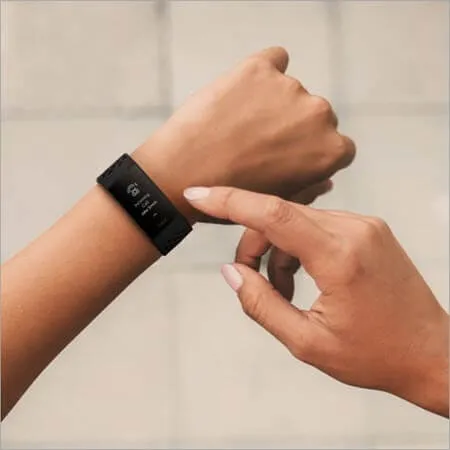Smartwatches and fitness trackers have become a part of everyday life for millions, offering convenience and health insights. However, a new study from the University of Notre Dame highlights a disturbing health concern: many smartwatch bands contain high levels of toxic PFAS (per- and polyfluoroalkyl substances), also known as “forever chemicals.” These substances, which don’t naturally break down, can be absorbed through the skin, raising significant health concerns.
What Are PFAS and Why Are They Dangerous?
PFAS are a group of approximately 15,000 synthetic chemicals commonly used to make products water-resistant, stain-resistant, or heat-resistant. Known for their durability, these chemicals have been linked to a variety of severe health problems, including:
- Cancer: Certain PFAS compounds are associated with an increased risk of cancers such as kidney and testicular cancer.
- Liver and Kidney Disease: Long-term exposure can damage these vital organs.
- Immune System Disruption: PFAS may reduce the body’s ability to fight infections and respond to vaccines.
- Reproductive and Developmental Issues: Birth defects and infertility have also been connected to PFAS exposure.
Because they are nearly indestructible in the environment, PFAS accumulate in the body over time, leading to long-term health risks.
The Study’s Findings
Researchers tested 22 popular smartwatch brands and found that 15 contained PFAS or markers of these chemicals. The levels were alarmingly high—comparable to those found in firefighting gear, which is designed to withstand extreme conditions.
The study specifically identified a synthetic compound known as PFHxA in 40% of the tested bands. This chemical, commonly used in clothing, carpets, and insecticides, is linked to liver disease and other health issues. Another compound detected, PFOA, is so toxic that the U.S. Environmental Protection Agency (EPA) considers virtually no level of exposure to it in drinking water safe.
How PFAS Affect the Body Through Smartwatch Bands
Smartwatch bands are worn directly against the skin for prolonged periods, making them a unique source of exposure. Studies have shown that PFAS can be absorbed through the skin, especially when combined with sweat during workouts. One earlier study found that up to 60% of certain PFAS compounds in a cream applied to the skin was absorbed—a rate that shocked researchers.
Given that many smartwatch bands are marketed as “sport” bands, the risk of PFAS absorption increases during physical activity, when sweating is more frequent.
Which Brands Are Affected?
While the Notre Dame study did not disclose specific brands, it noted testing on popular models from Nike, Apple, Fitbit, and Google. Many of these brands use fluoroelastomer materials, which are explicitly advertised as incorporating PFAS for their stain-resistant and dirt-repelling properties.
Ironically, smartwatch bands containing PFAS are often priced higher—up to $50 more—than those without these chemicals, making consumers unknowingly pay more for a potentially harmful product.
The Call for Safer Alternatives
Researchers recommend switching to silicone bands, which were found to be a safer alternative. Unlike synthetic rubber bands, silicone bands are less likely to contain PFAS, providing a healthier choice for consumers.
Graham Peaslee, a co-author of the study, advised consumers to be cautious:
- “I don’t need someone to rush to throw away their Christmas gifts,” he said, “but next time you buy one, move away from those with PFAS.”
The Role of Regulation
The findings highlight the urgent need for stricter regulation of PFAS in consumer products. Some countries, including the European Union, have proposed bans on PFHxA in items such as watch bands. However, in the U.S., regulation of PFAS in consumer goods remains limited.
Public awareness is a critical step toward reducing exposure. Educating consumers about the presence of PFAS in smartwatch bands and encouraging manufacturers to adopt safer materials can pave the way for healthier, more sustainable products.
What You Can Do
While PFAS are difficult to avoid entirely, there are steps you can take to minimize your exposure:
- Choose Silicone Bands: Opt for smartwatch bands made from silicone or natural materials.
- Check Labels: Avoid products labeled with “fluoroelastomer” or similar terms that indicate PFAS use.
- Support Regulatory Changes: Advocate for stronger regulations on PFAS in consumer goods.
- Stay Informed: Research products and materials before purchasing to ensure they are free from harmful chemicals.
The Bigger Picture: PFAS in Everyday Life
Smartwatch bands are just one of many sources of PFAS exposure. These chemicals are found in a wide range of products, including:
- Non-stick cookware
- Waterproof clothing
- Food packaging
- Carpets and upholstery
Addressing the PFAS crisis requires a comprehensive approach, including better manufacturing practices, stronger regulations, and increased public awareness.
The Notre Dame study sheds light on a hidden health risk that many smartwatch users may not have considered. As wearable technology becomes an integral part of daily life, understanding and addressing the potential hazards associated with these products is essential.
By making informed choices and advocating for safer alternatives, consumers can help drive change and reduce their exposure to harmful PFAS chemicals. Moving forward, it is imperative for manufacturers and regulators to prioritize public health over convenience and profitability, ensuring that products meant to enhance our lives do not inadvertently compromise our well-being.























